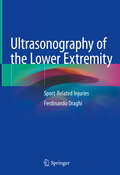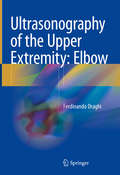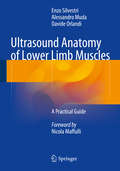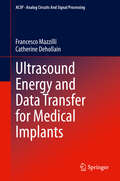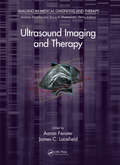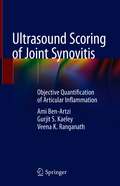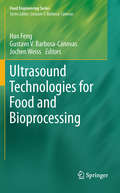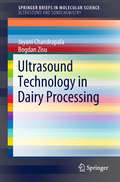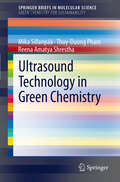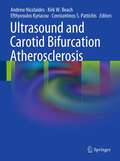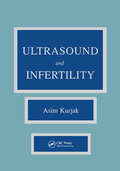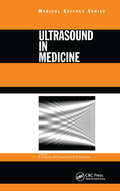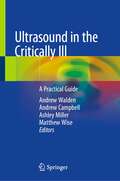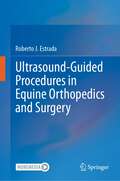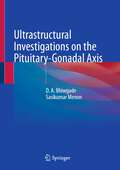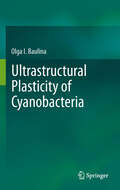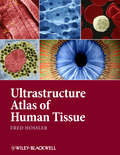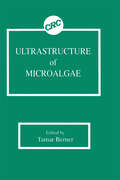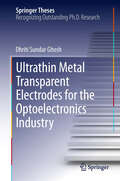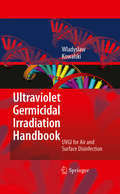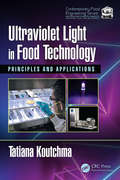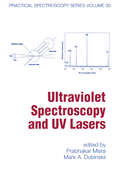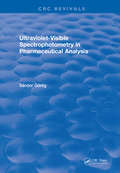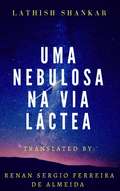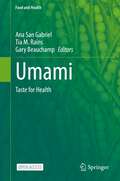- Table View
- List View
Ultrasonography of the Lower Extremity: Sport-Related Injuries
by Ferdinando DraghiThis book provides a detailed overview of ultrasound imaging of sport-related injuries of the lower extremity. The available literature focuses mainly on either clinical aspects or all imaging modalities and clinical aspects of sport-related pathologies, with little relevance on ultrasound. Indeed, recent advances in ultrasound technology, including high resolution, electronic, broadband transducers, have led to improved assessment of the musculoskeletal system, and ultrasound is now considered an optimal imaging technique to evaluate musculoskeletal sport-related injuries. Its advantages include the ability to perform dynamic examinations essential for many diagnoses, such as intrasheath instability of the peroneal tendons.Drawing on the author’s over 30 years of experience in clinical praxis, this book highlights the great potential of the ultrasonographic evaluation of sports-related injuries and is entirely devoted to this technique. Similar to the two previous monographs by the same author, the book has the form of an atlas-text, with a wealth of high-quality ultrasound images and schemes – a structure that has proved particularly effective for learning, especially for younger physicians. Ultrasonography of the lower extremity: sport-related injuries combines the interests of various specialists, including radiologists, physiatrists, orthopedists, rheumatologists, and ultrasound technicians.
Ultrasonography of the Upper Extremity: Elbow
by Ferdinando DraghiThis book on elbow ultrasonography is a practice-oriented book, offering a wealth of high-quality ultrasound images, and providing clear, concise, and comprehensive coverage of the normal anatomy as well as the main pathologic conditions of the elbow. The ultrasound images have been obtained using state-of-the-art scanners and carefully labeled to facilitate recognition of each condition. The book also provides a helpful comparison of the images and findings obtained using other diagnostic techniques, including magnetic resonance imaging. The text is complemented by practical tables summarizing key points for ease of reference. Ultrasonography of the Upper Extremity: Elbow is a rich source of information on the anatomy, examination techniques and ultrasound appearances of one of the anatomic regions to have benefited most from the technological revolution that has taken place in the field of ultrasonography in recent years. The book appeals to both novice and experienced practitioners, including above all radiologists and ultrasound technicians, as well as rheumatologists and orthopedic surgeons.
Ultrasound Anatomy of Lower Limb Muscles: A Practical Guide
by Enzo Silvestri Davide Orlandi Alessandro MudaThe book provides a comprehensive description of the basic ultrasound principles, normal anatomy of the lower limb muscles and classification of muscle strain injuries. Ultrasound images are coupled with anatomical schemes explaining probe positioning and scanning technique for the various muscles of the thigh and leg. For each muscle, a brief explanation of normal anatomy is also provided, together with a list of tricks and tips and advice on how to perform the ultrasound scan in clinical practice. This book is an excellent practical teaching guide for beginners and a useful reference for more experienced sonographers.
Ultrasound Energy and Data Transfer for Medical Implants (Analog Circuits and Signal Processing)
by Catherine Dehollain Francesco MazzilliThis book presents new systems and circuits for implantable biomedical applications, using a non-conventional way to transmit energy and data via ultrasound. The authors discuses the main constrains (e.g. implant size, battery recharge time, data rate, accuracy of the acoustic models) from the definition of the ultrasound system specification to the in-vitro validation.The system described meets the safety requirements for ultrasound exposure limits in diagnostic ultrasound applications, according to FDA regulations. Readers will see how the novel design of power management architecture will meet the constraints set by FDA regulations for maximum energy exposure in the human body. Coverage also includes the choice of the acoustic transducer, driven by optimum positioning and size of the implanted medical device. Throughout the book, links between physics, electronics and medical aspects are covered to give a complete view of the ultrasound system described.Provides a complete, system-level perspective on the use of ultrasound as energy source for medical implants;Discusses system design concerns regarding wireless power transmission and wireless data communication, particularly for a system in which both are performed on the same channel/frequency;Describes an experimental study on implantable battery powered biomedical systems;Presents a fully-integrated, implantable system and hermetically sealed packaging.
Ultrasound Imaging and Therapy (Imaging In Medical Diagnosis And Therapy Ser.)
by Aaron Fenster James C. LacefieldUp-to-Date Details on Using Ultrasound Imaging to Help Diagnose Various DiseasesDue to improvements in image quality and the reduced cost of advanced features, ultrasound imaging is playing a greater role in the diagnosis and image-guided intervention of a wide range of diseases. Ultrasound Imaging and Therapy highlights the latest advances in usin
Ultrasound Scoring of Joint Synovitis: Objective Quantification of Articular Inflammation
by Ami Ben-Artzi Gurjit S. Kaeley Veena K. RanganathA common manifestation of many autoimmune diseases is joint inflammation. The degree of inflammation of the joints is often used as a metric of disease activity. Assessing disease activity has diagnostic, therapeutic, and prognostic implications. Inflammation of the joints is often used as a proxy for inflammation in other tissue, and assessing this inflammation has implications for the health of numerous organs in in the body. Currently, physicians use palpation of joints to assess for joint inflammation. This method, while accessible and easy to apply, is lacking in precision. Ultrasound has also been used to assess for joint inflammation for over 20 years, but applying ultrasound technology has proved challenging. There is lack of agreement on optimal joint view, which joints should be examined in which disease, and how inflammation should be graded. Various scanning protocols and grading schemes have been proposed, but each has its strengths and weaknesses. Ultrasound Scoring of Joint Synovitis is based off the work of three authors who tackled the limitations of contemporary inflammation scoring systems, and developed an ultrasound-based inflammation scoring system which can be applied with consistency and reproducibility. In their research, the authors scanned thousands of joints and spent thousands of hours discussing the scans. They produced a scoring system which will allow the user of the atlas to grade joint inflammation in a way that is less subjective and more reproducible than the current systems used. Objective descriptions allow the user to quantify sonographic signs of joint inflammation with an intentional bias for the more clinically relevant features of ultrasound pathology. For students of musculoskeletal ultrasound, the book offers detailed descriptions of the sonographic appearance of every level of joint inflammation. For researchers, the book, and the system laid out in the book, are truly state-of-the-art and will enable better precision in research and clinical care of patients with joint inflammation.
Ultrasound Technologies for Food and Bioprocessing
by Hao Feng Jochen Weiss Gustavo Barbosa-CanovasTraditional food and bioprocessing technologies are facing challenges due to high expectation from the consumers and producers for better quality and safety, higher process efficiency, and products with novel properties or functionalities. For this reason, in the last few years new forms of physical energies have been explored to propose alternatives to traditional processing technologies. Acoustic energy has the potential to replace or partially substitute conventional processes, and at the same time offer unique opportunities in the characterization of foods and biomaterials. This book is a resource for experts and newcomers in the field of power ultrasound, gives insights into the physical principles of this technology, details the latest advancements, and links them to current and potential applications in the food and bioprocessing related industries.
Ultrasound Technology in Dairy Processing (SpringerBriefs in Molecular Science)
by Jayani Chandrapala Bogdan ZisuThis SpringerBrief provides an overview of the use of ultrasound in various dairy applications, highlighting their significant benefits for the dairy industry, including energy savings and product improvement. It describes in detail the physical and chemical effects of high- and low-frequency power ultrasound in specific applications such as emulsification, ultrafiltration, crystallisation, inactivation of microbes, functionality modifications of secondary dairy products and fat separation.Although to date the majority of these applications have only been proven in the laboratory, some have been successfully implemented on a larger scale. By offering a concise review that includes the transition from laboratory-scale projects to large-scale commercialization, this SpringerBrief fills a gap in the literature. Ultrasound processing has the advantage of minimising flavour loss, increasing homogeneity, reducing energy requirements, reducing processing times, enhancing end-product quality, reducing chemical and physical hazards and lowering the environmental impact compared to conventional dairy processes. As a result, the use of ultrasound in the dairy industry has become a hot topic and has generated considerable research interest in recent years. The SpringerBrief is intended for industry professionals, researchers and graduate students with a basic understanding of simple ultrasound, especially those starting on a new topic of research or coming into the field.
Ultrasound Technology in Green Chemistry
by Reena Amatya Shrestha Mika Sillanpää Thuy-Duong PhamAs a new and rapidly growing science, the applications of ultrasound methods in environmental technology hold a promising future. Compared to conventional methods, ultrasonication can bring several benefits such as being environmentally friendly (no toxic chemical are used or produced), low cost, and compact, allowing on-site treatment. Besides an overview featuring the background behind ultrasonic technology, this brief summarizes the main studies and innovations reported in recent research that has utilized ultrasound methods in environmental analysis, water, and sludge treatment, soil and sediment remediation to air purification.
Ultrasound and Carotid Bifurcation Atherosclerosis
by Efthyvoulos Kyriacou Kirk W. Beach Constantinos S. Pattichis Andrew NicolaidesUltrasound and Carotid Bifurcation Atherosclerosis provides a comprehensive overview of the most recent advancements in instrumentation, imaging techniques including the use of contrast enhancement agents, plaque image analysis and its automation, elastography and plaque motion analysis; also, the use of ultrasonic and other biomarkers in the detection of the high risk cardiovascular individual. Finally, it deals with the application of IVUS, TCD and carotid plaque characterization in clinical practice and in stroke risk stratification. Ultrasound and Carotid Bifurcation Atherosclerosis is intended for all those working in the field of atherosclerosis, ultrasound imaging and cardiovascular risk, including the clinician, the vascular ultrasonographer, the epidemiologist, the molecular biologist, the biomedical engineer and the informatics scientist. Furthermore, this book bridges the gap between the researcher and the clinician, who is keen to incorporate the latest results of research to his daily practice.
Ultrasound and Infertility
by Asim KurjakA comprehensive survey of the use of ultrasound in management of infertile patients is presented in this publication. Particular atten-tion is given to recently developed techniques such as assessment of endometrial changes, ovarian blood flow measurements, and per-cutaneous oocyte retrieval for in vitro fertilization. The very re-cent technique of transvaginal sonography is presented and richly illus-trated with original results obtained in biopsy-guided oocyte re-trieval, and in the precise delineation of follicle size and number for infertility treatment. Guidance in the interpretation of ultrasonic findings, which include potential limitations and pitfalls, is provided in each chapter. Researchers and practitioners interested in the management of infertile patients will find this volume indispensable.
Ultrasound in Medicine (Series in Medical Physics and Biomedical Engineering)
by Francis A Duck Andrew C Baker Hazel C StarrittUltrasound in Medicine is a broad-ranging study of medical ultrasound, including ultrasound propagation, interaction with tissue, and innovations in the application of ultrasound in medicine. The book focuses specifically on the science and technology-the underlying physics and engineering. It examines the most closely related aspects of these basic sciences in clinical application and reviews the success of technological innovations in improving medical diagnosis and treatment. The book bridges the gap between tutorial texts widely available for ultrasound and medical training and theoretical works on acoustics.
Ultrasound in the Critically Ill: A Practical Guide
by Andrew Campbell Ashley Miller Andrew Walden Matthew WiseThis book provides a practically applicable guide to the use of ultrasound in the care of acutely and critically ill patients. It is laid out in two sections. The first section attempts to take a comprehensive approach to specific systems of examination taking an organ focused approach covering techniques including Focussed Assessment with Sonography for Trauma (FAST) scanning and venous sonography. The second section presents a range of specific cases enabling the reader to develop an understanding of how to apply these methodologies effectively into their day-to-day clinical practice.Ultrasound in the Critically Ill: A Practical Guide describes how to use ultrasound technologies in day-to-day clinical practice. Therefore, it is an ideal resource for all trainee and practicing physicians who utilize these technologies on a day-to-day basis.
Ultrasound-Guided Procedures in Equine Orthopedics and Surgery
by Roberto J. EstradaThis book serves as a practical guide for equine veterinarians in orthopedics and surgery. It reviews and summarizes the current scientific evidence of the most commonly performed ultrasound-guided procedures for ultrasound-assisted surgery and injections.For the first time, different techniques are compiled and richly illustrated with pictures and videos to guide the practitioner step-by-step. An initial discussion about the general principles of ultrasound-guided procedures sets the bases for clinicians to understand the general technique and apply it to each approach. Additional chapters describe the most common ultrasound-guided injections in different anatomical structures as well as the surgical approaches that are aided or guided with ultrasound.All over the world ultrasound-guided procedures are performed daily in many different fields of equine practice. The main objective of using these approaches is to increase accuracy and minimize tissue trauma when performing diagnostic and therapeutic procedures. Equine orthopedics and surgery are among the major applications of these techniques.Learn about ultrasound-assisted techniques and be part of this trend! Maximize your capacity as a veterinarian, directly affecting the health of your patients. You can access the supplementary videos directly on your smartphone or tablet; simply download the Springer Nature More Media App for free and scan the links with the play button.
Ultrastructural Investigations on the Pituitary-Gonadal Axis
by D. A. Bhiwgade Sasikumar MenonThis book provides the ultrastructural study of the pituitary–gonadal axis through the electron microscope. It is a compilation of extensive work carried out by Dr. D.A. Bhiwgade and his researchers over the last four decades. It explains the ultrastructural characteristics of pituitary cells in different morphological states and provides a comprehensive approach to identifying the structural and functional distinctions between various pituitary cell types. The book includes ultrastructural evaluations of the testis and epididymis after different experimental interventions to study the physiological correlations of the organs with spermatogenesis and the consequent structural deformities in sperm. An extensive section of different types of placentae is added for understanding the varied interactions of fetal and maternal tissues in the placental barrier. Placental types seen in bats, shrews, rodents, and monkeys are explained at the ultrastructural level to distinguish the tissue interrelationships within different placental layers. Detailed sketches have been provided to illustrate the correlations between the maternal and fetal tissues in different placental types for better understanding. This book is a ready reckoner and offers guidance to researchers and clinicians in understanding the cellular architecture and intracellular changes associated with various physiological states and clinical conditions of the pituitary, testis, epididymis, and placenta. This book offers assistance to all those using electron microscopy to evaluate cellular and tissue systems.
Ultrastructural Plasticity of Cyanobacteria
by Olga I. BaulinaThis book offers an in-depth analysis of the cell biology of cyanobacteria, a group of phototrophic microorganisms performing an important function in the biosphere. The chapters present the author's and her colleagues' pioneering investigations of the ultrastructure of cyanobacteria under high-light and dark conditions, during irradiation by extremely high fluxes of light, in the course of L-transformation and within model associations and natural symbioses with plants. Diverse patterns of ultrastructural change are illustrated in electron micrographs and schematics. The book further introduces a new concept of "bacterial ultrastructural plasticity" - the reversible rearrangement of ultrastructure in response to environmental changes, as a strategy for finding and investigating cell adaptation mechanisms and intraspecies structural diversity of cyanobacteria and other prokaryotes. It serves as a valuable guide for teaching and research in the field of cell biology of microorganisms and plant-cyanobacteria symbioses.
Ultrastructure Atlas of Human Tissues
by Fred HosslerUltrastructure Atlas of Human Tissues presents a variety of scanning and transmission electron microscope images of the major systems of the human body. Photography with the electron microscope records views of the intricate substructures and microdesigns of objects and tissues, and reveals details within them inaccessible to the naked eye or light microscope. Many of these views have significance in understanding normal structure and function, as well as disease processes. This book offers a unique and comprehensive look at the structure and function of tissues at the subcellular and molecular level, an important perspective in understanding and combating diseases. • Presents the major systems of the human body through scanning and transmission electron microscope images • Has images prepared almost exclusively from human tissues • Includes electron micrographs of common pathologies such as fibrotic and emphysemic lung, kidney stones, sickle cell anemia, and skin parasites • Contains sets of 3D images in most chapters
Ultrastructure of Microalgae
by Tamar BernerUltrastructure of Microalgae provides both fundamental and specific information regarding the ultrastructure of the major components of the microalgal cell. The book compares homologous structures in different groups within an evolutionary frame of reference. It covers all taxa and structures, and it incorporates new concepts that have resulted fro
Ultrathin Metal Transparent Electrodes for the Optoelectronics Industry
by Dhriti Sundar GhoshTransparent electrodes (TEs) are a class of materials that make it possible to bring electrical current or potentials in close proximity to optically active regions without significant loss of optical energy. However, it is a challenge to decouple the electrical and optical properties of a material, as the property of conductivity is strongly coupled to the imaginary part of the refractive index. An ideal TE has high transparency in combination with very low electrical resistivity. The main objective of the thesis was to develop TEs which can replace expensive, scarce and fragile Indium Tin Oxide (ITO), the most widely used TE material in the industry today. The thesis contains original work on ultrathin metal film (UTMF)-based TEs, which are essential elements in a wide range of optoelectronics, consumer electronics and energy devices. It presents new designs and fabrication methods and demonstrates the efficient use of UTMF-TEs in organic light emitting diodes and solar cells, achieving similar levels of efficiency to that of state-of-the-art ITO.
Ultraviolet Germicidal Irradiation Handbook
by Wladyslaw KowalskiThis book is a comprehensive source for technical information regarding ultraviolet germicidal irradiation (UVGI) and its application to air and surface disinfection for the control of pathogens and allergens. The primary focus is on airborne microbes and surface contamination applications for hospitals, commercial facilities, and residential homes. All aspects of UVGI systems, including design methods, sizing methods, modeling, safety, installation, testing, guidelines, and disinfection theory are addressed in detail. An extensive database of over six hundred UV rate constant studies is included as well as tabular performance data for UV lamps and products. Providing this information in one single source simplifies the design and installation of UVGI systems, helps guarantee effective performance of new systems, and facilitates their use on a wide scale for the purpose of improving human health. This book is organized to provide systematic coverage of all related issues and will serve equally well as both a textbook and a handbook for general reference.
Ultraviolet Light in Food Technology: Principles and Applications (Contemporary Food Engineering #2)
by Tatiana KoutchmaUV light is one of a number of emerging non-thermal food processing technologies that can be used in a broad range of applications producing food products with longer shelf-life, more safe, and with higher nutritional quality. The new edition of Ultraviolet Light in Food Technology: Principles and Applications will present recent understanding of the fundamentals of UV light along with new applied knowledge that has accumulated during the 7 years since the first edition published in 2009. The new edition of the book will have 11 chapters including 2 new chapters--on chemical destruction with UV light and food plant safety—along with 6 chapters greatly expanded and updated.
Ultraviolet Spectroscopy And Uv Lasers
by Prabhakar Misra Mark A. DubinskiiThis volume presents a complete and thorough examination of advances in the instrumentation, evaluation, and implementation of UV technology for reliable and efficient data acquisition and analysis. It provides real-world applications in expanding fields such as chemical physics, plasma science, photolithography, laser spectroscopy, astronomy and a
Ultraviolet-Visible Spectrophotometry in Pharmaceutical Analysis
by S. GorogThis book provides an overview of the state of the art in pharmaceutical applications of UV-VIS spectroscopy. This book presents the fundamentals for the beginner and, for the expert, discusses both qualitative and quantitative analysis problems. Several chapters focus on the determination of drugs in various matrices, the coupling of chromatographic and spectrophotometric methods, and the problems associated with the use of chemical reactions prior to spectrophotometric measurements. The final chapter provides a survey of the spectrophotometric determination of the main families of drugs, emphasizing the achievements of the last decade.
Uma nebulosa na Via Láctea
by Lathish Shankar Renan S F AlmeidaAmelia, uma colegial, é receptiva a eventos Paranormais. Uma vez ela escreveu um artigo para a revista de sua escola, na qual ela declara que às vezes ouve vozes vindas do futuro. Stephen, o professor de Física, lê o artigo e conversa com sua esposa, Isabella. Isabella diz que Amelia é sua paciente, e sofre de hemofobia. Esta é razão pela qual ela não comparecera à aula de Zoologia. Ela deu entrada no hospital depois de desmaiar na cafeteria, enquanto tomava sorvete com seus amigos, Rosemary, Merlin, Prince e Neil. Stephen, dolorosamente, se dá conta de que ele conhecera Amelia, anos antes, e ele próprio era a única razão para sua doença mental. Sentido-se muito culpado pelo que acontecera no passado, ele procura seu amigo Zachariah John, um cientista. Zachariah vive com sua filha única, Zarina. Zachariah ajuda Stephen a viajar de volta no tempo e corrigir o erro que ele cometera sem querer. Stephen volta para o passado em sua máquina do tempo, muda o passado e então retorna para o futuro. Será que ele conseguiu consertar tudo? Que mudanças o futuro sofrera por causa de suas alterações na linha do tempo? Será que ele desejaria que o futuro acontecesse de tal maneira? Leia para conehce rmais mais dessa incrível história de ficção científica sobre viagem no tempo.
Umami: Taste for Health (Food and Health)
by Gary Beauchamp Ana San Gabriel Tia M. RainsThis Open Access book covers the concept of umami, the unique taste imparted by the amino acid glutamate, was first described in 1908 by Dr. Kikunae Ikeda of Tokyo University. Over the past century, hundreds of studies have explored the mechanistic underpinnings of the taste, leading to the characterization of the umami taste receptor in 2002. How this fifth basic taste figures into nutrition and health, however, remains underexplored.Umami: Taste for Health provides an overview of the relationship between umami and human health. Authors explain how glutamate not only produces a characteristic oral sensation in the mouth but also functions as a signaling molecule to induce physiological responses. With the support of recent studies, the book demonstrates how the taste properties of umami make glutamate a promising substance to lower salt intake, promote satiation and support healthier aging. The text also covers practical culinary applications to increase umami flavor and practical usage of umami for promoting healthy eating.Provides an overview of the relationship between umami and human health;Explores the potential of glutamate to lower salt intake, promote satiation and support healthier aging;Covers practical culinary applications of umami flavor and practical usage of umami for promoting healthy eating.
